
I’ve always been somewhat cynical when it comes to Syracuse’s early season scheduling. I put my thoughts in print last year and thought the Orange needed a tougher early season schedule to build a championship caliber team. After six games this season and some extensive research, I’ve learned it’s not the competition that matters, but rather the score when gauging long term winning potential.

Currently sporting a 24.2 average margin of victory, the Orange is hammering its opponents. With a tough 9-point win on the road in Arkansas serving as the only single digit triumph, this year’s team has been making impressive statements against strong and lesser opponents alike. Of course, as Syracuse head coach Jim Boeheim as noted, there are still improvements to be made, but this team is off to a very strong start.
» Related: What does SU legend Hakim Warrick think of this year’s team?
Why should we make a big deal over the margin of victory? Because if the last 25 years tells us anything, it’s that just winning throughout the season isn’t enough in college basketball- you need to win in dominant fashion.
It was exactly 25 seasons ago when Danny and the Miracles shocked the basketball world as Kansas won the NCAA Title. It was so shocking because their average margin of victory was a lowly 4.9 point per game. It would take 23 years before another team, UCONN in 2011 with a 7.4 point AMV, would win the big dance. Who was the third lowest in the past 25 years, you ask? Syracuse in 2003 with a 10 point AMV. Outside of those three teams we the champion’s AMV ranges from 13.1 to a mind-blowing 22 ppg.
How did those three teams buck the trend and win? Danny Manning, Carmelo Anthony, and Kemba Walker; three college superstars who caught fire and whose play inspired otherwise ordinary teammates to do extraordinary things and surpass all reasonable expectations.
» More from Matt Goodman: What we’ve learned about Syracuse after four games
The remaining 22 champions fielded dominating teams for the entire season and rode that supremacy to the finish line. Excluding the Walker led UCONN team, the other eight champions since Syracuse in 2003 have ranked in the top-3 each season in margin of victory. And five of those eight were No. 1 overall.
What does all of this mean for this year’s Syracuse Orange? Well, with all due respect to Michael Carter-Williams, the Orange lacks that transcendent superstar to will them to a championship. So they will need to slide into domination mode if they want to truly be a contender.
As a result, for the first time in years, I’ll be closely examining the upcoming games against Long Beach State, Monmouth, Canisius, and so forth. While we may not learn how the Orange will handle close games and tight pressure situations, we will see just how dominant it can be. If MCW and company can string together a bunch of 20-plus point blowouts, it’s a strong possibility the Orange can end up averaging more than the 19.8 margin of victory it averaged last season prior to Big East competition.
» Related: Syracuse’s press effective against EMU
Last season’s squad finished with 13.1 AMV. Had Fab Melo not been ruled ineligible, that team certainly had a chance at National Championship. This year’s team has been surprising to many, including myself, given the huge loss of talent and experience, might be even better.
Until we progress deep into the season and the competition level spikes, we won’t truly know the ceiling for this team. But the one thing we do know is that these early season blowouts do serve a purpose – as an early indicator of how dominant this team can be. And college basketball history has shown us, time and time again, that season long domination is a trademark of being a champion.
For more Syracuse coverage, Like our Facebook page and follow us @TheJuiceOnline.

